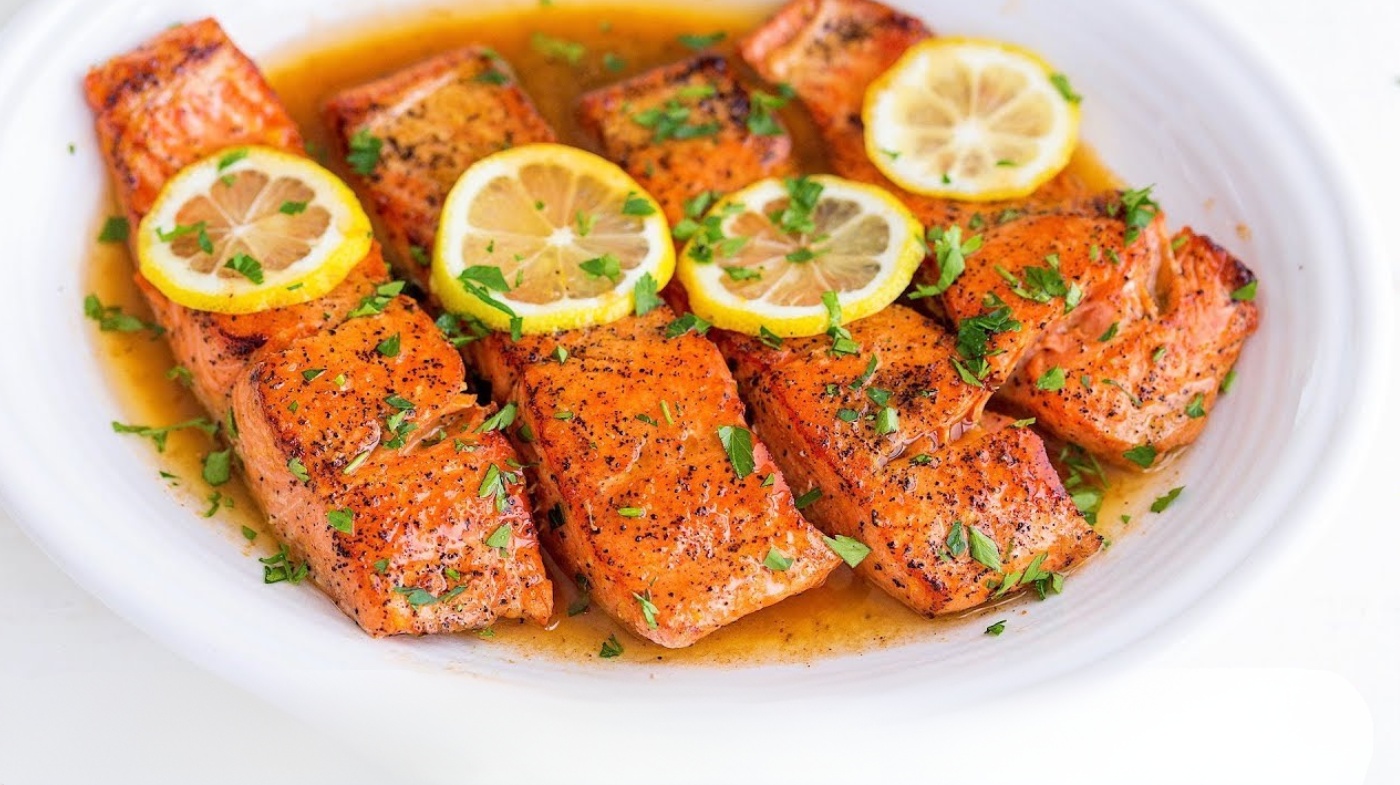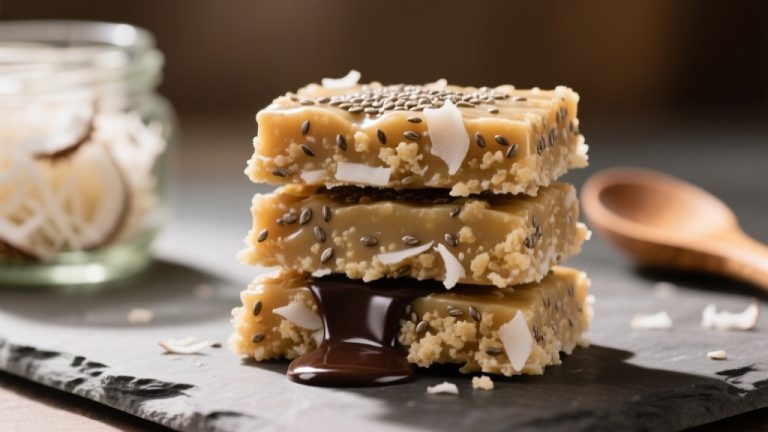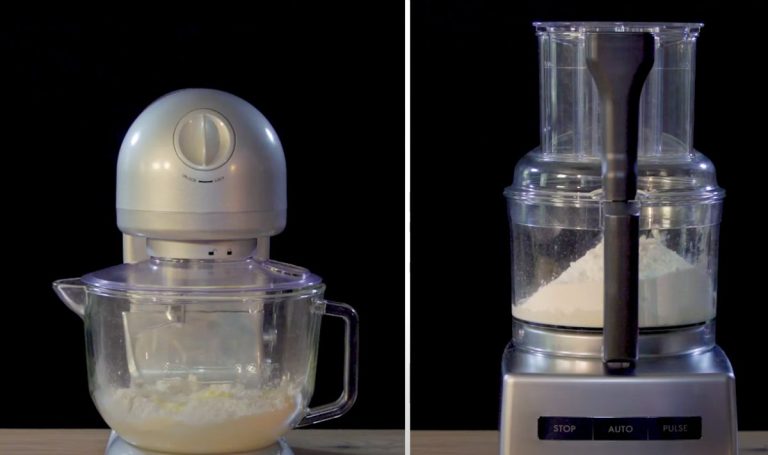Keta Salmon Recipe: Healthy and Flavorful Every Time
Choose firm, fresh keta salmon fillets with vibrant pink color and intact skin for the best flavor and texture. Season them simply with salt, pepper, olive oil, and fresh herbs, then bake at 350°F for 15-25 minutes or sauté for a golden crust in just minutes per side.
Enhance your dish with a honey-soy glaze or spicy sweet chili sauce for a burst of flavor. Keep exploring to discover tips on sesame crusts, perfect sauces, and ideal pairings.
Key Takeaways
- Select fresh, firm Keta salmon fillets with vibrant pink color and intact skin for optimal flavor and texture in your recipe.
- Season fillets with salt, pepper, olive oil, fresh herbs, and lemon to enhance the natural salmon taste before cooking.
- Bake Keta salmon at 350°F for 15-25 minutes or sauté skin-side down on medium-high heat for 3-4 minutes per side.
- Prepare a glaze using honey, soy sauce, garlic, and ginger for a sweet, umami-rich sauce that complements the salmon.
- Garnish with fresh herbs, lemon slices, and green onions to add brightness and visual appeal to the finished dish.
Quick Guide to Cooking Keta Salmon
| Ingredients | Process |
|---|---|
| Fresh keta salmon fillets (6-8 oz each) | Select fresh, firm fillets with a vibrant pink color and intact skin for best flavor and texture. Check for a mild oceanic scent and avoid dull or slimy pieces. |
| Salt and black pepper | Pat fillets dry. Season simply with salt and pepper to enhance natural flavors before cooking. |
| Olive oil | Lightly brush fillets with olive oil to keep moisture and help crisp the skin during cooking. |
| Fresh herbs (parsley, basil, or dill) | Add fresh herbs to the seasoning mix or garnish the finished salmon for aromatic complexity and color. |
| Lemon (slices and juice) | Use lemon slices while baking or squeeze fresh lemon juice over the salmon before serving to add brightness and a fresh zing. |
| Honey | Mix honey into a glaze for a gentle sweetness that balances savory notes. |
| Low-sodium soy sauce | Combine soy sauce with honey and aromatics for a rich umami glaze that complements keta salmon perfectly. |
| Garlic and fresh ginger | Mince garlic and grate fresh ginger to add pungent, warming flavor to marinades and sauces. |
| Sesame seeds (white, black, or mixed) | Press sesame seeds onto fillets for a crunchy crust, especially when paired with sesame oil for extra aroma. |
Selecting the Best Keta Salmon Fillets
How do you pick the best keta salmon fillets to guarantee a delicious and healthy meal? First, look for fillets with a firm, dense texture that springs back when pressed—this shows freshness.
The color should be a consistent pale pink to orange-pink without dark spots, except for natural skin marks. Choose fillets with intact skin and minimal bruising to preserve flavor during cooking.
Fillet size typically ranges from 6 to 8 ounces, ideal for even cooking. Since keta salmon is lean with lower fat, avoid fillets that appear dry or slimy.
Opt for vacuum-sealed or freshly cut fillets sold on ice to ascertain quality. These steps help you enjoy keta’s mild flavor and health benefits in every bite, as it is an excellent source of omega-3 fatty acids.
Essential Ingredients for Flavorful Keta Salmon
To bring out the best in your keta salmon, start with quality fillets and essential flavor enhancers like olive oil, fresh herbs, and a touch of lemon.
You’ll want to balance savory, sweet, and tangy notes using sauces and garnishes such as soy glaze, garlic butter, or a dill-yogurt drizzle.
These key ingredients work together to create a vibrant, well-rounded dish that highlights the salmon’s natural richness.
For an optimal cooking process, preheat your oven to 425°F and roast the salmon skin-side down in a hot skillet to achieve a perfect texture and flavor.
Key Salmon Components
Although Keta salmon has a milder flavor and leaner texture than other salmon varieties, you can bring out its full potential by carefully selecting key ingredients that enhance its natural qualities.
This firm, moderately oily fish absorbs marinades beautifully, so you’ll want to use citrus like lemon juice and zest to brighten its subtle flavor. Soy sauce adds essential saltiness and umami depth, while honey introduces a gentle sweetness that complements the fish.
Fresh herbs such as parsley or basil provide aromatic complexity, and pungent garlic and ginger warm up the seasoning profile. In Japan, Keta salmon is traditionally valued for drying, salting, marinating, and cooking, reflecting its versatility and culinary potential in Japan.
For cooking, olive oil preserves moisture and carries flavors into the salmon, ensuring each bite is tender and flavorful.
Flavor Enhancers Overview
When you want to reveal the full flavor potential of Keta salmon, understanding the essential flavor enhancers is key.
Salt and sugar form the foundation, with salt amplifying the fish’s natural taste and brown sugar adding a balanced sweetness that deepens flavor. The subtle caramelization from sugars during smoking enriches aroma and complexity.
Choosing the right smoke, like alder wood, adds delicate smokiness without overpowering the salmon’s mild profile. Cold and hot smoking methods influence texture and smoke intensity, layering flavor uniquely. The Pacific Sustainable Seafood brand offers wild Keta salmon that emphasizes sustainability and quality.
Oils such as soybean oil improve moisture and help distribute flavors evenly. Though preservatives maintain freshness and color, they don’t directly boost taste.
Together, these carefully selected enhancers create the complex, memorable flavor that makes Keta salmon truly special.
Sauce and Garnish Choices
Building on the flavor enhancers that bring out the best in Keta salmon, the right sauces and garnishes elevate the dish to new heights.
You can create a balanced soy-based glaze using low-salt soy sauce, honey, grated ginger, and minced garlic, adding Dijon mustard or Sriracha for complexity.
Sweet chili sauce brushed on before baking offers a sweet, spicy glaze that caramelizes beautifully under heat. Baking at 450 degrees Fahrenheit ensures the sauce forms a perfect caramelized finish.
Brighten the rich fish with lemon slices or juice and fresh herbs like basil or parsley, which add vibrant aroma and color. Finish with a brush of reserved sauce, sprinkle chopped green onions or fresh chili peppers for crisp texture and mild heat.
Preparing Keta Salmon for Cooking
Start by choosing fresh keta salmon fillets that are firm and vibrant in color for the best taste. Carefully remove the skin and pin bones to guarantee a smooth texture and safe eating experience.
Then, prepare your marinades and sauces with bold flavors to infuse the salmon before cooking. For optimal moisture retention during baking, it is preferable to keep the fillets skin-on.
Selecting Fresh Keta Fillets
Although selecting fresh keta salmon fillets might seem straightforward, knowing what to look for guarantees you get the best quality for your recipe. Focus on appearance, texture, and odor to make a confident choice.
- Appearance: Look for lighter orange-pink flesh that’s moist and slightly translucent. Avoid fillets with dull color, brown spots, or excessive liquid. If skin’s present, it should be shiny with vibrant silver hues and no slime.
- Texture: Press gently—fresh keta salmon feels firm and bounces back quickly. Mushy or flaky flesh means it’s past prime. Keta salmon is known for its lower oil content, which contributes to its mild flavor and makes texture an important freshness indicator.
- Odor: Fresh fillets have a mild oceanic scent. Skip any with strong fishy or ammonia-like smells.
Removing Skin and Bones
Once you’ve selected fresh keta salmon fillets, the next step is to prepare them by removing the skin and bones.
To remove skin easily, pour boiling water briefly over the skin side or sear it skin-side down for a few minutes—this loosens the skin for smooth peeling. Alternatively, use a sharp knife at the tail to create a starting edge and peel carefully, avoiding tearing the flesh. It is important to ensure the fillets are descaled and pin-boned to achieve the best texture and flavor.
Next, run your fingers gently over the fillet to locate pin bones, then use fish bone tweezers or needle-nose pliers to pull them out along the grain, preserving the fillet’s shape.
Rinse the fillet lightly afterward, pat dry, and trim ragged edges for even cooking and a polished presentation.
Prepping Marinades and Sauces
When you prepare marinades and sauces for keta salmon, balancing sweet, salty, acidic, and spicy elements is key to enhancing the fish’s natural richness.
Start by whisking together soy sauce, honey, and citrus juice to create a harmonious base. Freshly grated ginger, minced garlic, and spring onions add vibrant, pungent notes that elevate the flavor complexity.
Consider these essential steps:
- Use low sodium soy sauce to control saltiness and highlight other flavors.
- Brush the marinade on before baking, then reapply after cooking to build a glossy, flavorful glaze.
- Incorporate herbs like basil or parsley for freshness and garnish appeal. For example, lemon juice, honey, garlic, and fresh basil combine to create a delicious sauce that can be used to cover the salmon before baking, enhancing both moisture and flavor during cooking lemon-basil sauce.
Baking Techniques for Perfect Keta Salmon
Mastering the baking techniques for keta salmon guarantees you get a moist, flavorful dish every time. Start by patting your fillets dry and seasoning them with salt, pepper, and fresh herbs.
Bake at 350°F for 15-25 minutes or up to 450°F for 16-20 minutes if you’re short on time; use foil packets to seal in moisture and infuse flavors with lemon slices and garlic butter.
For a crispy, caramelized finish, broil the salmon for 1-3 minutes after baking. Use lightly greased baking sheets or parchment-lined pans to prevent sticking.
Remember to adjust baking times based on thickness and whether your salmon is fresh or frozen. It is also recommended to bake in a preheated oven to ensure even cooking. Once done, rest your salmon briefly to lock in juices before serving.
Sautéing Keta Salmon to Perfection
Start by patting your keta salmon fillets dry and seasoning them simply to set the stage for a perfect sear. Heat a heavy pan over medium to medium-high heat until it’s hot enough to create a crisp, golden crust without burning.
Cook the salmon skin-side down for about 3 to 4 minutes before flipping, adjusting time based on thickness to achieve ideal doneness. Because keta salmon fillets are generally thinner, they tend to cook faster than other varieties, so careful timing is essential to avoid overcooking and dryness thinner fillets.
Preparing Fillets Properly
Because proper preparation sets the foundation for a perfect sauté, you’ll want to handle your keta salmon fillets with care before cooking.
Start by patting the fillets dry to remove excess moisture, which helps achieve a beautiful sear and browning. Next, carefully remove any pin bones with tweezers to guarantee a safe, enjoyable eating experience. Finally, trim uneven edges so the fillets cook evenly without thin parts overcooking.
Here’s a quick checklist:
- Pat fillets dry to promote crispness.
- Remove pin bones for safety and texture.
- Trim edges for uniform cooking.
Gently season the fillets with salt and pepper or a light marinade, and lightly oil them to enhance flavor while keeping the crust intact. Handle the fillets delicately to maintain their structure before sautéing.
Ideal Pan Temperature
Once your keta salmon fillets are prepped and seasoned, controlling the pan temperature becomes key to achieving that perfect sear.
Heat your cast iron or heavy-bottomed skillet over medium-high heat until it reaches around 375°F to 400°F—usually 2 to 3 minutes. Add olive oil just before placing the fillets skin-side down to crisp the skin and render fat.
Maintaining the correct temperature is especially important for keta salmon, which has low oil content compared to other salmon types, so careful heat control prevents drying out the flesh. Maintain steady heat for 4-5 minutes, then flip and lower to medium to gently cook the flesh. Watch for a golden crust; if oil smokes or burns, reduce heat immediately. If the fillet looks pale or won’t sizzle, increase heat slightly.
Proper temperature guarantees a crispy exterior and moist interior, releasing rich, caramelized flavors without drying or undercooking your salmon.
Cooking Time Guidelines
Although cooking times can vary depending on the thickness of your keta salmon fillets, aiming for about 3 to 4 minutes per side on medium-high heat usually delivers a beautifully seared exterior and moist interior.
To perfect your sauté:
- Start skin side up to develop a rich browning without overcooking, then flip for equal time uncovered.
- Use a preheated heavy skillet with oil or butter to guarantee even heat and prevent sticking.
- Check internal temperature aiming for 110-125°F and look for opaque flesh that flakes easily.
Keta salmon, like other types of salmon, is rich in omega-3 fatty acids, which promote better skin, hair, and nails. Adjust timing for thicker or thinner cuts and rest the salmon briefly after cooking to let juices redistribute.
Creating Delicious Honey-Soy Glaze
When you combine honey’s natural sweetness with the rich umami of soy sauce, you create the foundation for an irresistible glaze that elevates keta salmon to new heights. To deepen flavor, add finely grated ginger and garlic, plus a splash of rice vinegar or lemon juice for brightness.
Simmer gently, stirring often, until thickened but still pourable. Marinate the salmon briefly, then baste during cooking for a glossy, caramelized finish.
For the best texture, consider dry curing the salmon with a salt and sugar mixture before glazing, as this firms up the flesh and enhances flavor, resulting in a more satisfying bite thanks to the dry cure process.
| Ingredient | Purpose |
|---|---|
| Honey | Sweetness, balances savoriness |
| Soy Sauce | Umami, saltiness |
| Ginger & Garlic | Pungency, depth |
| Rice Vinegar/Lemon | Acidity, brightness |
| Aromatics | Complexity, aroma |
Making a Spicy Sweet Chili Sauce for Salmon
Crafting a spicy sweet chili sauce for your salmon lets you infuse bold flavors that perfectly balance heat and sweetness.
Start with Thai sweet chili sauce as your base, then add fresh garlic and grated ginger for aromatic spice. Incorporate soy or fish sauce for umami depth and lime juice to brighten the mix. You can find Thai sweet chili sauce at most supermarkets or online, making it easy to source quality ingredients.
Here’s how to make it:
- Whisk together sweet chili sauce, soy sauce, garlic, ginger, and a splash of water for a balanced glaze.
- Marinate your salmon in the sauce for 10–30 minutes to let the flavors penetrate.
- During cooking, baste the salmon with the sauce to create a sticky, caramelized coating.
Adjust chilis and lime juice to tailor the heat and acidity, ensuring a vibrant, flavorful finish on your keta salmon.
Tips for Sesame Seed Crusted Keta Salmon
A handful of simple steps can transform your keta salmon into a flavorful sesame seed crusted delight. Start by patting the salmon dry to help the seeds stick and lightly coat it with sesame or olive oil—sesame oil brings an authentic nutty aroma.
Season simply with salt, pepper, and a squeeze of lemon juice to brighten and tenderize. Squeeze juice of lemon on salmon for enhanced flavor and moisture. Press white, black, or mixed sesame seeds firmly onto one side, covering the entire surface for an even, crunchy crust.
Cook seed-side down first by searing in a non-stick pan, then finish baking at 375°F for 20-25 minutes to lock in moisture. Avoid flipping too much to keep the crust intact. Handle gently and taste sauces beforehand to balance flavors perfectly.
Serving Suggestions and Side Pairings
Although keta salmon shines on its own, pairing it with the right sides can elevate your meal to a memorable experience. Complement your salmon with vibrant vegetables, hearty grains, and flavorful sauces to create balance and depth.
- Vegetables: Roast asparagus or sauté spinach with garlic to add texture and brighten the plate. A fresh green salad with citrus vinaigrette also adds crispness.
- Grains & Starches: Serve jasmine rice or roasted fingerling potatoes for warmth and substance. Cauliflower mash offers a creamy, low-carb alternative. Because chum salmon has a lower oil content, these sides help maintain moisture and complement its mild flavor.
- Sauces & Garnishes: Drizzle caramelized honey garlic sauce or squeeze fresh lemon wedges over the salmon. Finish with fresh herbs like parsley for aromatic freshness.
Nutritional Benefits of Keta Salmon
When you choose keta salmon, you’re fueling your body with a powerhouse of essential nutrients. Each 3-ounce serving delivers 20-22 grams of high-quality protein, supporting muscle growth, strength, and metabolism. Its rich omega-3 content—about 683 mg per serving—boosts heart health, reduces inflammation, and sharpens brain function.
You’ll also get 167% of your daily vitamin B12, crucial for nerve health and red blood cell formation, plus potassium for heart and muscle function.
Keta salmon, also known as chum salmon, is part of the genus Oncorhynchus, which is derived from Greek words meaning “hooked nose.” With just 120 calories and low saturated fat, keta salmon fits perfectly into a heart-healthy diet.
Plus, wild Alaska keta salmon is sustainably sourced, ensuring nutrient-rich freshness year-round. Choosing keta means nourishing your body while supporting eco-friendly fishing practices.
Frequently Asked Questions
Can I Freeze Raw Keta Salmon Fillets Before Cooking?
Yes, you can freeze raw keta salmon fillets before cooking.
Just make sure you rinse and pat them dry, then wrap them tightly in an airtight container or vacuum seal to avoid freezer burn.
Freeze at 0°F or below, and use within 2-3 months for best quality.
When ready, thaw them gradually in the fridge overnight to preserve texture and flavor.
Avoid thawing at room temperature to keep it safe and fresh.
What Is the Best Way to Thaw Frozen Keta Salmon Safely?
Imagine the slow, quiet transformation as your frozen salmon begins to soften—this is best done in your fridge, below 40°F.
You’ll want to plan ahead, letting it thaw overnight or for 6-8 hours to keep its texture and flavor intact.
If you’re pressed for time, seal it tight and submerge in cold water, changing it every 15 minutes.
Either way, cook it right after thawing to keep it safe and delicious.
How Long Can Cooked Keta Salmon Be Stored in the Refrigerator?
You can store cooked keta salmon safely in your refrigerator for 3 to 4 days.
Make sure you cool it to room temperature within two hours after cooking, then seal it tightly in an airtight container or wrap it well.
Keep your fridge below 5°C (41°F) to slow bacterial growth.
Always check for off smells or slimy textures before eating, and avoid storing it in the fridge door to maintain even cooling.
Are There Any Common Allergies Associated With Keta Salmon?
Imagine the thrill of savoring tender, flaky fish that can trigger unexpected reactions.
Yes, you can be allergic to keta salmon, as it shares common allergens with other salmon types. The main culprit is the Sal s 1 protein, causing symptoms like hives, swelling, or even breathing trouble.
If you’re sensitive to finned fish, your immune system might mistake keta salmon proteins as foes, so always proceed with caution.
Can Keta Salmon Be Substituted With Other Types of Salmon in Recipes?
You can definitely substitute keta salmon with other types, but keep its firmer texture and mild flavor in mind.
If you want richer taste or more oily texture, coho or king salmon works better.
Sockeye’s stronger flavor might overpower delicate dishes, so adjust seasonings if you swap it in.
Keta holds up well in grilling or sandwiches, so choose your substitute based on the recipe’s texture and flavor needs.
Transform Your Weeknight Dinners with Keta Salmon
As you savor your perfectly cooked keta salmon, think of it as more than just a meal—it’s a vibrant canvas painted with flavors and textures. Each bite symbolizes the harmony between nature’s bounty and your culinary touch.
By choosing quality fillets and mastering these techniques, you’re not just feeding your body but nourishing your soul. Let this dish remind you that great cooking is an art, where passion and patience come together to create something truly memorable.







